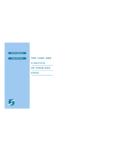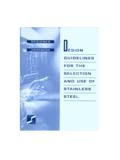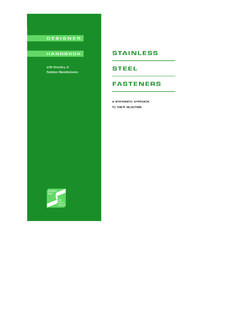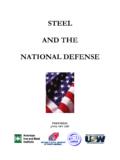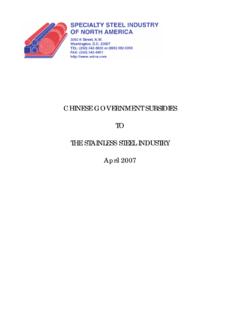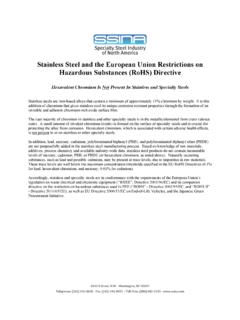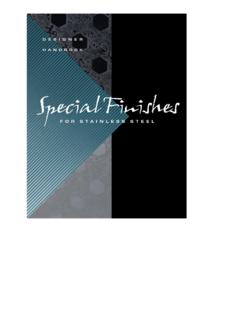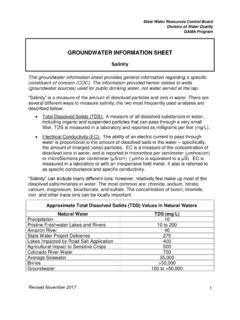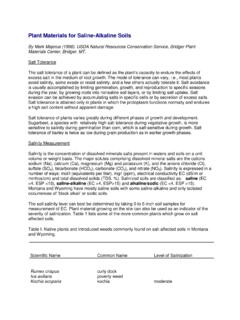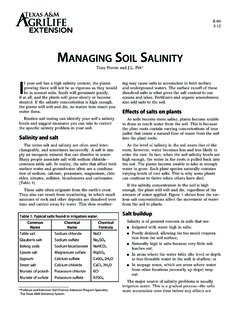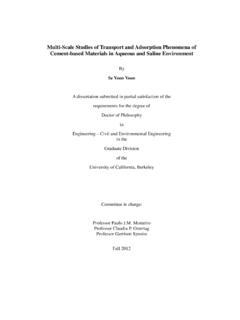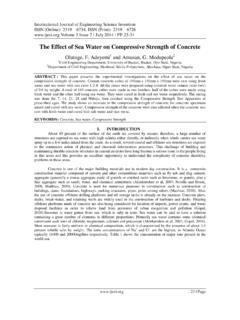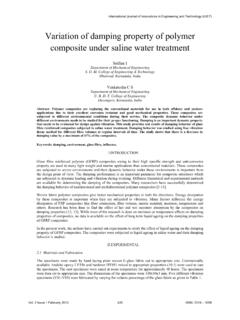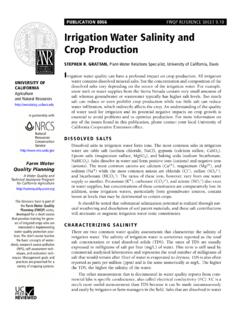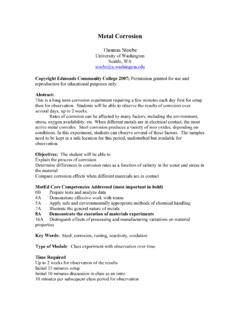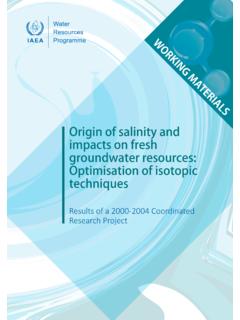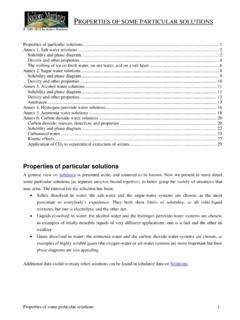Transcription of HANDBOOK for coastal - SSINA
1 DESIGNERHANDBOOK stainless steel for coastal and salt corrosionTABLE OF CONTENTS:INTRODUCTIONCASE STUDY ONE:STREET LEVEL APPLICATIONSCASE STUDY TWO:EXTERIOR WALL PANELSAND WINDOW FRAMESCASE STUDY THREE:LIGHT STANDARDS stainless steelis not a single alloy, but rather thename applies to a group of iron based alloys containing a minimum chromium. Other elements are added and thechromium content increased to improve corrosion resistance andother properties. There are over 50 stainless steel grades that were originally recognized by the American Iron and Steel Institute(AISI). Three general classifications are used to identify stainlesssteel. They are..The various types of stainless steels are detailed in a designer HANDBOOK Design Guidelines for the Selection and Use of Stainless Steel available online at or from the Specialty Steel Industry of North America ( SSINA ) by calling the toll free number.
2 HANDBOOK is designed to acquaint the reader with the 300 series stainlesssteels, particularly grades 304 and 316 and their applications in areas wherecoastal or salt corrosion is a factor in the life of a metal structureThe AISI numbering system (200, 300 & 400 series numbers)The Unified NumberingSystem, which was developedby the American Society forTesting Materials (ASTM) and the Society of AutomotiveEngineers (SAE) to apply toall commercial metals Specialty Steel Industry ofNorth America ( SSINA ) and theindividual companies it representshave made every effort to ensurethat the information presented inthis HANDBOOK is technically correct. However, neither theSSINA nor its member companieswarrants the accuracy of theinformation contained in thishandbook or its suitability for anygeneral and specific use.
3 TheSSINA assumes no liability orresponsibility of any kind in connection with the use of thisinformation. The reader is advisedthat the material contained hereinshould not be used or relied on for any specific or general applications without first securingcompetent BROCHURE-LAYOUT 9/27/02 8:36 AM Page 4 Stainless Steel is the generally accepted terminology applied toiron based alloys thatcontain at least Many people are familiar with chromium as acorrosion-resistantcoating on the surfaceof a chrome-platedpart, such as an automobile bumper. Instainless steel, however,the chromium is addedduring the melting ofthe steel and forms ahomogeneous mixturewith the iron and otheralloying elements, such as nickel andmolybdenum, whichenhance the metal sresistance to 304 (UNS 30400),the basic 18-8 alloy(18% chromium, 8%nickel), is the mostcommon of the 300series and has excellentcorrosion resistance in most 316 (UNS 31600),has an addition of atleast 2% molybdenum,which significantlyincreases the metal sresistance to salt is stainlesssteel?
4 Carbon steel containsat least 95% iron withup to 2% carbon. Thehigher the carbon content, the strongerthe steel. Stainlesssteel also contains iron,but in addition it mustcontain at least and the carbon content is verylow, usually Stainlesssteel gets it strengthfrom the metallurgicalstructure, rather thanfrom the amount of carbon steel can bestrengthened by heattreatment whereas the300 series stainlesssteels cannot. Stainless steel can bestrengthened by work-hardening the 300 series stainlesssteel grades (304 and316) contain nickel from8 to 14% in addition tothe chromium that mustbe present. 316 containsan additional element,molybdenum, from 2 to3%. It is these alloyingelements added to theiron base that makesstainless steel very different from is stainless steel different from carbon steel?
5 The Specialty Steel Industry of North Americaproduces a HANDBOOK Selection and Use of Stainless Steel available from the web is the iron in carbonsteel that reacts withthe oxygen in theatmosphere to produce iron-oxides which wecan see as red rust on the steel creates a layerof oxide on the surfacethat is several timesthicker than the originaliron present and oftenresults in a spalling orflaking of the surface,reducing the carbon steel corrodesstainless steel applicationsfor coastal andsalt corrosion02381 BROCHURE-LAYOUT 9/27/02 8:36 AM Page 6 Because stainless steelcontains at least , the oxidationof the iron is changedto produce a complexoxide that resists furtheroxidation and forms apassive layer on thesurface.
6 This is a verythin layer (microns in thickness) but verytenacious and willreform if it is removedby scratching ormachining. The additionof nickel to the structure(8% minimum in 304and 10% minimum in316) broadens therange of passivityestablished by thechromium. The furtheraddition of molybdenum(2% minimum in 316)furtherexpands thepassivity range andimproves corrosionresistance, notable inacetic, sulfuric, andsulfurous acids and inneutral chloride solutionsincluding sea stainless steel isproperly selected andmaintained it should nothow stainlesssteel resistscorrosionsuffer any steel will,however, corrode undercertain conditions. It is not the same type of corrosion as experienced by carbonsteel. There is nowholesale rusting ofthe surface and subsequent reductionof thickness.
7 If stainlesssteel corrodes, the mostlikely form of corrosionis pitting. Pitting occurswhen the environmentoverwhelms the stain-less steel s passive filmand it cannot heal theinterruption. It usuallyoccurs in very tiny dark brown pits on thesurface (hence thename pitting), and doesnot interfere with themechanical propertiesof the stainless steel can also become subject tocrevice corrosion whenthe deposits or other material (like a washer)creates a crevice onthe surface. It is similarto pitting but over alarger area where againthe environment hasoverwhelmed the abilityof the passive layer to heal itself whendeprived of oxygen. Itis not attractive, but inmost cases it should notaffect the mechanicalproperties of the stain-less steel.
8 Good designto eliminate sharp corners or seal themwill minimize this typeof the United Statesand Canada, the presence of salt ladenmist from the oceans,chloride concentrationsin rain water (see map on the following page)and the use of deicingsalts in Northern ormountainous regionsresults in corrosion ofapplicationssteel in many applica-tions. Upgrading the useof stainless steel from304 to 316 has shownto be of significant helpin reducing the effectsof corrosion in severalapplications, some ofwhich are shown in courtesy of Nickel Development InstituteThe functional pier in this photowas completed in 1941 and used220 tons of Type 304 reinforcingbar. It is one of the oldest concretestructures in North America and is located in Progresso, Mexico.
9 A casual visitor might assume thatthe remnants of the non-functionalpier pre-date the functional pier,but they would be mistaken. Thenon-functional pier was completedabout 30 years ago and used carbon steel rebar. Corrosion ofthe carbon steel caused the concrete to fail. It would havebeen much more cost effective to use stainless steel rebar. 02381 BROCHURE-LAYOUT 9/27/02 8:37 AM Page 8 Chlorides in airbornesea spray, rain, and drysalt particles carriedby wind may cause pitting and rusting ofstainless steels, unlessa sufficiently corrosionresistant grade is chosen. The distanceairborne salt is carriedcan vary significantlywith local wind , locationswithin five to ten miles(9 to18 km) of salt waterare considered at riskfor chloride-related corrosion, but localweather patterns andthe performance ofmetals near the siteshould be evaluatedprior to material selection.
10 In somelocations, marine saltaccumulations are onlya factor within the miles or kmfrom the shore. In otherlocations, salt may becarried much furtherinland. The map belowshows the averagechloride concentration(mg/1) in rainfall acrossthe United States. Thechlorides in rainwaterare primarily marinesalts carried inland byweather inrainwaterThe above map showsthe influence of deicingand marine salts, corrosive pollutants(SO2, NOX, H2S andNH4), and particulateon North Americanvehicle corrosion. SO2and NOXcan form sulfuric and nitric acidin the atmosphere andbecome acid rain. This research is relevantfor all metals and othertypes of street-levelapplications. Pleasenote, this is a generalguideline and theremay be areas charac-terized as low or highcorrosion areas wherelocalized corrosion levels are different fromthe level BROCHURE-LAYOUT 9/27/02 8.
